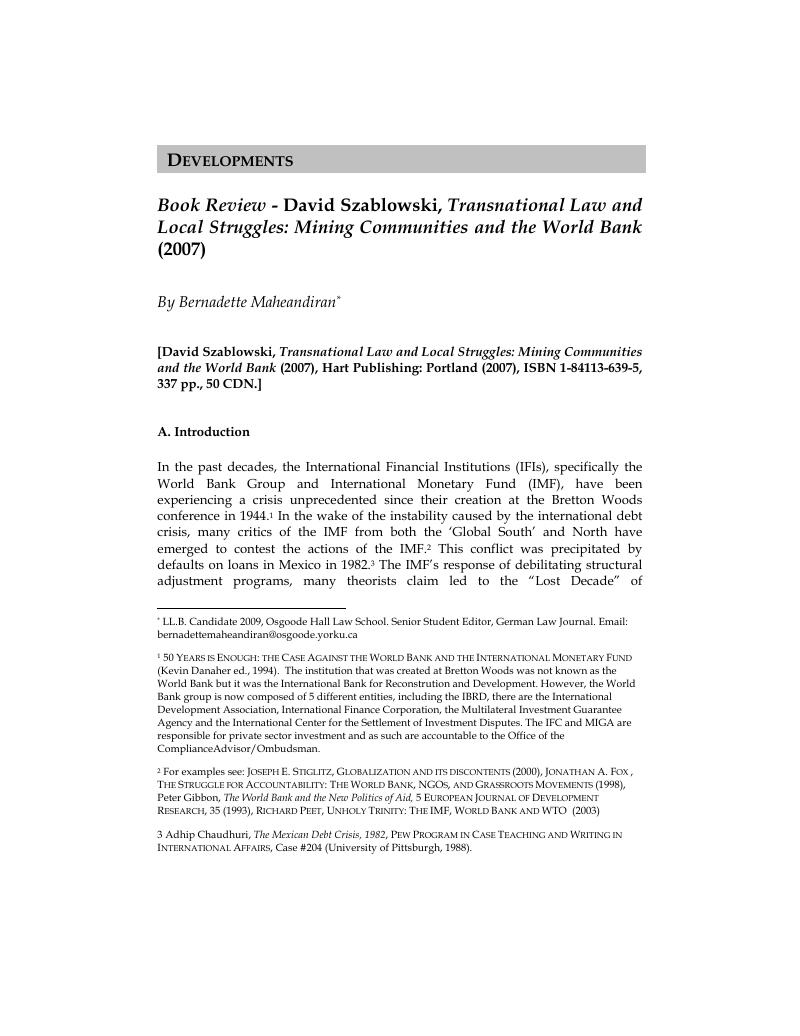No CrossRef data available.
Published online by Cambridge University Press: 06 March 2019

1 50 Years is Enough: the Case Against the World Bank and the International Monetary Fund (Kevin Danaher ed., 1994). The institution that was created at Bretton Woods was not known as the World Bank but it was the International Bank for Reconstrution and Development. However, the World Bank group is now composed of 5 different entities, including the IBRD, there are the International Development Association, International Finance Corporation, the Multilateral Investment Guarantee Agency and the International Center for the Settlement of Investment Disputes. The IFC and MIGA are responsible for private sector investment and as such are accountable to the Office of the ComplianceAdvisor/Ombudsman.Google Scholar
2 For examples see: Joseph E. Stiglitz, Globalization and its discontents (2000), Jonathan A. Fox, The Struggle for Accountability: The World Bank, NGOs, and Grassroots Movements (1998), Peter Gibbon, The World Bank and the New Politics of Aid, 5 European Journal of Development Research, 35 (1993), Richard Peet, Unholy Trinity: The IMF, World Bank and WTO (2003)Google Scholar
3 Chaudhuri, Adhip, The Mexican Debt Crisis, 1982, Pew Program in Case Teaching and Writing in International Affairs, Case #204 (University of Pittsburgh, 1988).Google Scholar
4 See Michaels, Marguerite, Retreat from Africa, 72 Foreign Affairs, 98 (1993), Robin Broad, John Cavanagh and Walden Bello, Development: The Market is Not Enough in International Political Economy: Perspectives on Global Power and Wealth, 392 (Jeffry A. Frieden & David A. Lake, eds., 4. ed., 2000), August B. Friscia and Judith L. Kovacs, Beyond the Lost Decade: Debt and Development in Latin America (1994)Google Scholar
5 Sanjeev Khagram, Restructuring World Politics: Transnational Social Movements, Networks, and Norms 206–213 (2002).Google Scholar
6 Stiglitz, supra, note 2.Google Scholar
7 Amartya Sen, Development as Freedom (1999)Google Scholar
8 Balakrishnan Rajagopal, International Law from Below: Development, Social Movements, and Third World Resistance, 152 (2003).Google Scholar
9 Khagaram, supra, note 5.Google Scholar
10 Office of the Compliance Advisor/Ombudsman, “About Us,” available at http://www.caoombudsman.org/html-english/about.htm.Google Scholar
11 David Szablowski, Transnational Law and Local Struggles: Mining, Communities and the World Bank 170–177 (2007).Google Scholar
12 Id. Google Scholar
13 Id., 182–201.Google Scholar
14 Id., 11.Google Scholar
15 Id., 15–18.Google Scholar
16 Id., 22–23.Google Scholar
17 Id., 298–304.Google Scholar
18 Id., 27–60.Google Scholar
19 Id., 61–100.Google Scholar
20 Extractive Industry Transparency Initiative, available at http://www.eitransparency.org.Google Scholar
21 Draft Norms on the Responsibilities of Transnational Corporations and Other Business Enterprises with Regard to Human Rights, E/CN.4/Sub.2/2003/12 (2003), available at http://www1.umn.edu/humanrts/links/NormsApril2003.html.Google Scholar
22 Szablowski, supra note 11, 184.Google Scholar
23 Id., 137–162.Google Scholar
24 This is not the typical complaint mechanism. Today, complaints would be directed to the Office of the Compliance Advisor/Ombudsman. Id., 224–228.Google Scholar
25 Id., 243–249.Google Scholar
26 The World Bank Operational Material, Involuntary Resettlement, OP 4.12 (2005) available at http://wbln0018.worldbank.org/institutional/manuals/opmanual.nsf/023c7107f95b76b88525705c002281b1/ca2d01a4d1bdf58085256b19008197f6?OpenDocument.Google Scholar
27 The World Bank Operational Material, Involuntary Resettlement, OD 4.30, Para 3, (1990) available at http://www.worldbank.org/html/fpd/em/power/wbpolicy/430OD.stm.Google Scholar
28 Id. Google Scholar
29 Id. Google Scholar
30 Szablowski, supra, note 11, 259.Google Scholar
31 Id., 119.Google Scholar
32 Id., 124–127.Google Scholar
33 Id., 261–281.Google Scholar
34 Id., 243–249.Google Scholar
35 Id. Google Scholar
36 James Ferguson, The Anti-Politics Machine: ‘Development', Depoliticization, and Bureaucratic Power in Lesotho (1990).Google Scholar
37 Gernot Brondnig, The World Bank and Human Rights: Mission Impossible, Carr Center for Human Rights Policy Working Paper T-01-05, 1–21.Google Scholar
38 Andrea Cornwall and Celestine Nyamu-Musembi, Putting the ‘rights-based approach’ to development into perspective, 25 Third World Quarterly, 1415 (2004).Google Scholar
39 Szablowski, supra, note 11, 119.Google Scholar
40 Id., 285.Google Scholar
41 Anthony Anghie, International Financial Institutions in The Politics of International Law in The Politics of International Law, 217, 235 (Christian Reus-Smit ed., 2004).Google Scholar
42 Id., 218.Google Scholar
43 Id. Google Scholar
44 Max Weber, The Theory of Social and Economic Organization (1947).Google Scholar
45 Szablowski, , supra, note 11, 13.Google Scholar
46 Id., 13–17.Google Scholar
47 Id., 292.Google Scholar
48 Margaret Keck and Kathyrn Sikkink. Activists Beyond Borders: Advocacy Networks in International Politics (1998).Google Scholar
49 Fox, Jonathan A., The World Bank Inspection Panel: Lessons from the First Five Years, 6 Global Governance, 279, 289 (2000).Google Scholar
50 Rajagopal, , supra, note 8, 155.Google Scholar